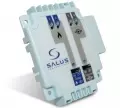DSL
The abbreviation "DSL" stands for "Digital Subscriber Line," which translates into Slovak as "Digital Access Line." DSL is a technology for data transmission over traditional telephone lines. It is one of the most widespread methods for connecting to the Internet in homes and small businesses.

Here are some key characteristics of DSL:
Digital technology: DSL uses digital technology for data transmission, which means that the analog voice signal from the telephone line is converted to a digital signal for data transmission. This technology enables high-speed data transmission over traditional telephone lines.
Asymmetric speed: Most DSL connections are asymmetric, which means that the download speed is different from the upload speed. Typically, download speeds are faster, which is beneficial for common activities such as browsing websites and downloading files.
Distance and speed: The speed of a DSL connection can be affected by the distance from the telecommunications operator's headquarters. The closer you are to the central office, the faster the connection can be. There are different variants of DSL with different speeds, including ADSL (Asymmetric DSL), VDSL (Very High Bitrate DSL) and others.
Stability: DSL connections are usually stable and uninterrupted, which is important for online activities such as video streaming and online gaming.
Competition with other technologies: DSL currently competes with modern technologies such as fiber optic and cable connections, which often offer higher connection speeds. Despite this, DSL is still a widespread and affordable way to connect to the Internet, especially in areas where other technologies are not available.
Overall, DSL is an Internet connection technology that uses existing telephone lines to transmit digital data. It is one of the options for connecting to the Internet and is suitable for many common online activities.






















































































































































